Google’s 200 Ranking Factors: The Complete List
Written by Brian Dean
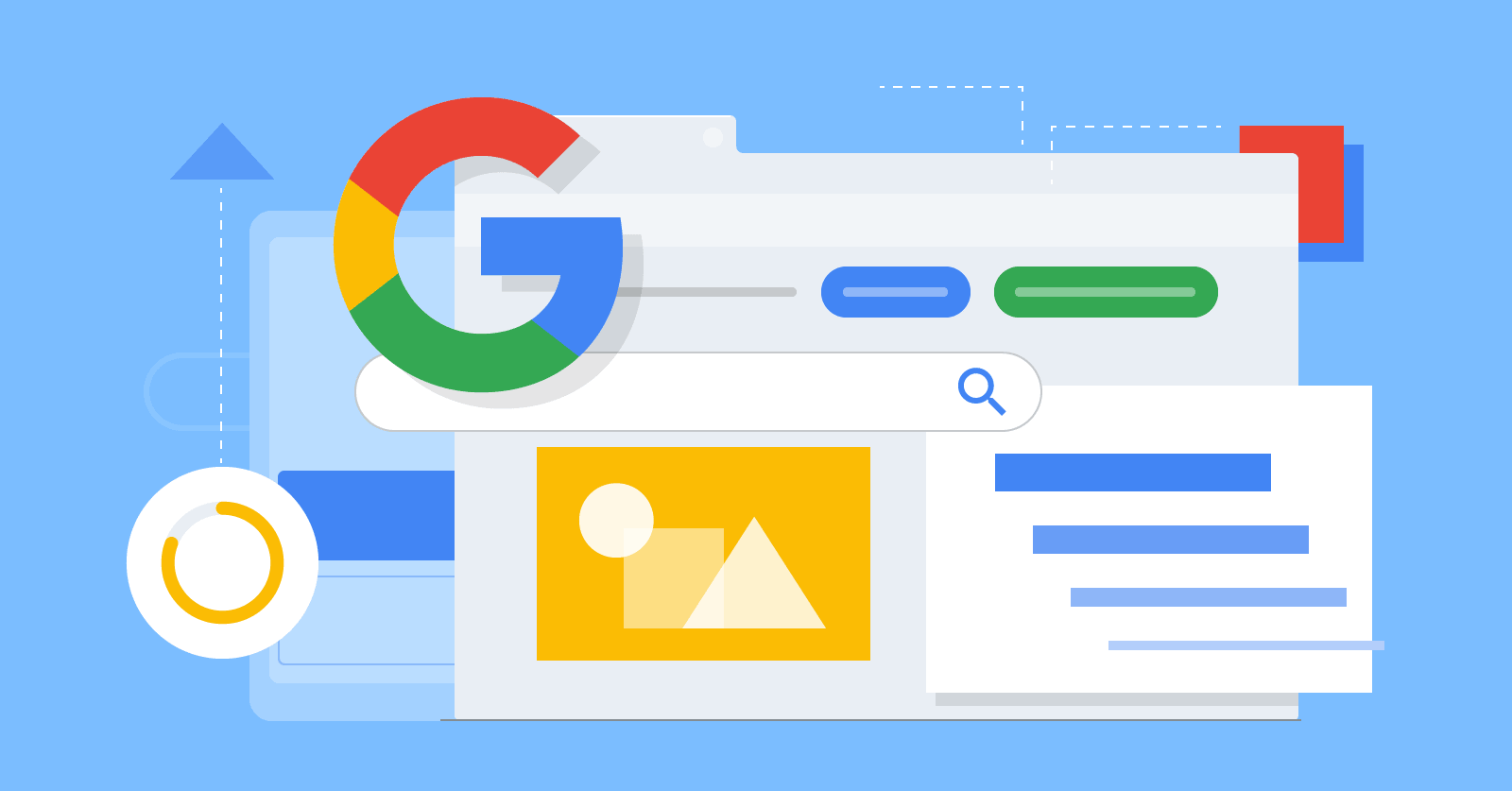
You might already know that Google uses over 200 ranking factors in their algorithm…
But what are they, exactly?
Well, you’re in for a treat because I’ve put together a complete list.
Some are proven.
Some are controversial.
Others are SEO nerd speculation.
But they’re all here.
And I recently updated this entire list for 2024.
Let’s dive right in.
- The Top 8 Factors
- Domain Factors
- Page-Level Factors
- Site-Level Factors
- Backlink Factors
- User Interaction
- Special Google Algorithm Rules
- Brand Signals
- On-Site Webspam Factors
- Off-Site Webspam Factors
The Top 8 Factors
These are the top 8 SEO ranking factors. There are 200+ other factors that Google takes into account, but these are the ones that you should focus on first:
- Quality Content: The most important SEO factor. Google wants to show users high-quality, informative, and relevant content.
- Backlinks: Links from other websites to your website. They act like votes of confidence. The more high-quality backlinks you have, the higher your website will rank.
- Technical SEO: The technical aspects of your website, such as its website speed, mobile-friendliness, and crawlability. Make sure your website is technically sound so that search engines can easily index and understand your content.
- Keyword Optimization: The process of using relevant keywords throughout your website’s content. This helps search engines understand what your website is about.
- User Experience (UX): A measure of how easy and enjoyable it is for users to use your website. Google wants to show users websites that provide a good UX.
- Schema Markup: A type of structured data that you can add to your website to help search engines better understand your content.
- Social Signals: The likes, shares, and other social interactions that your website’s content receives. Make sure your website is shareable and encourages social interaction.
- Brand Signals: The overall perception of your brand online. Make sure your brand is well-known and respected.
Domain Factors
1. Domain Age: Many SEOs believe that Google inherently “trusts” older domains. However, Google’s John Mueller has said “domain age helps nothing“.
2. Keyword Appears in Top Level Domain: Having a keyword in your domain name doesn’t give you the SEO boost that it used to. But it still acts as a relevancy signal.
3. Domain registration length: A Google patent states:
“Valuable (legitimate) domains are often paid for several years in advance, while doorway (illegitimate) domains rarely are used for more than a year. Therefore, the date when a domain expires in the future can be used as a factor in predicting the legitimacy of a domain.”
4. Keyword in Subdomain: Moz’s expert panel agrees that a keyword appearing in the subdomain can boost rankings.

5. Domain History: A site with volatile ownership or several drops may tell Google to “reset” the site’s history, negating links pointing to the domain. Or, in certain cases, a penalized domain may carry the penalty over to the new owner.
6. Exact Match Domain: Exact Match Domains probably have little to no direct SEO benefit. But if your EMD happens to be a low-quality site, it’s vulnerable to the EMD update.
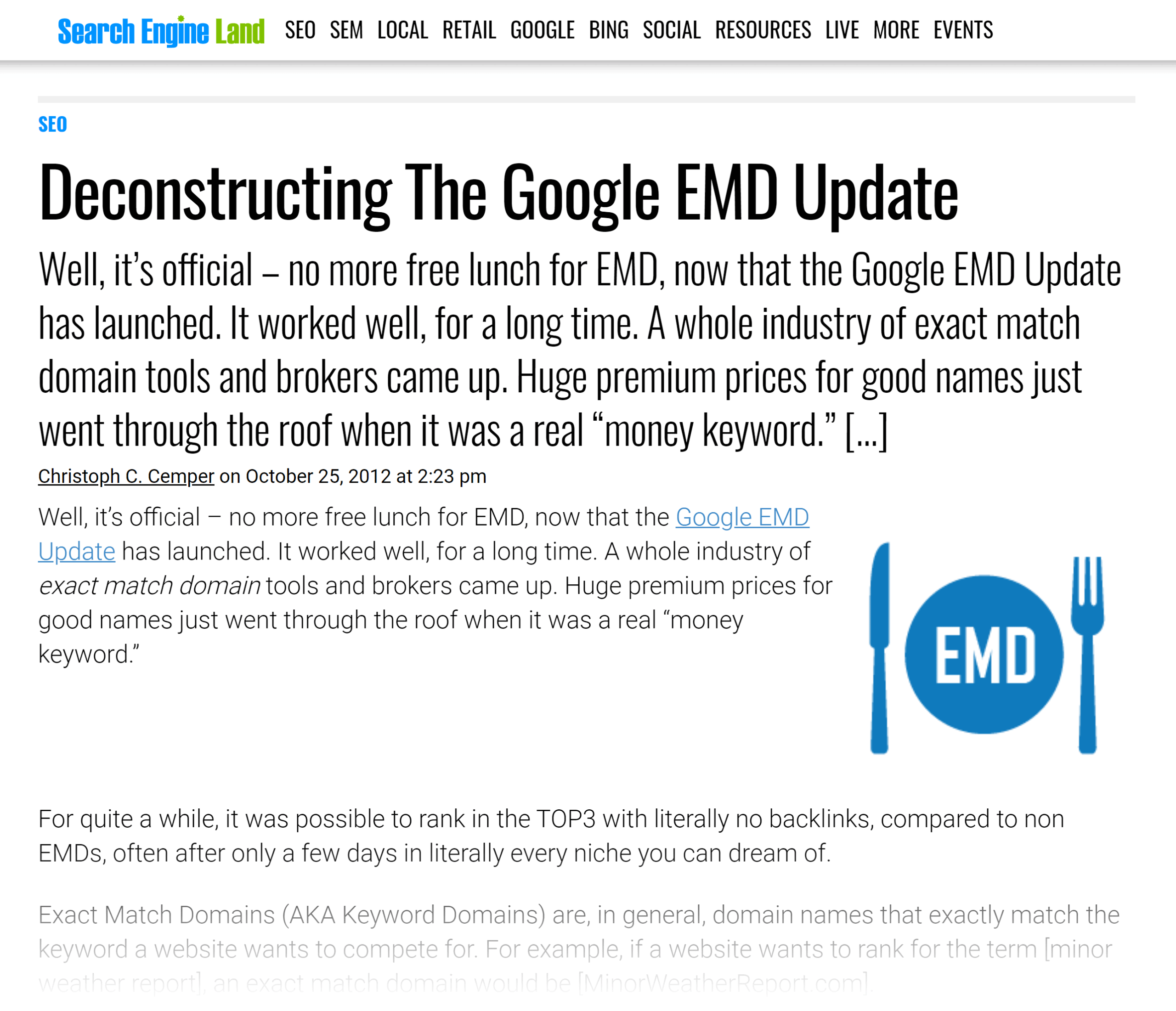
7. Public vs. Private WhoIs: Private WhoIs information may be a sign of “something to hide”. Googler Matt Cutts is quoted as stating:
“…When I checked the whois on them, they all had “whois privacy protection service” on them. That’s relatively unusual. …Having whois privacy turned on isn’t automatically bad, but once you get several of these factors all together, you’re often talking about a very different type of webmaster than the fellow who just has a single site or so.”
8. Penalized WhoIs Owner: If Google identifies a particular person as a spammer it makes sense that they would scrutinize other sites owned by that person.
9. Country TLD extension: Having a Country Code Top Level Domain (.cn, .pt, .ca) can sometimes help the site rank for that particular country… but it can limit the site’s ability to rank globally.
Page-Level Factors
10. Keyword in Title Tag: Although not as important as it once was, your title tag remains an important on-page SEO signal.

11. Title Tag Starts with Keyword: According to Moz, title tags that start with a keyword tend to perform better than title tags where the keyword appears at the end of the tag.
12. Keyword in Description Tag: Google doesn’t use the meta description tag as a direct ranking signal. However, your description tag can impact click-through-rate, which is a key ranking factor.
13. Keyword Appears in H1 Tag: H1 tags are a “second title tag”. Along with your title tag, Google uses your H1 tag as a secondary relevancy signal, according to results from one correlation study:

14. TF-IDF: A fancy way of saying: “How often does a certain word appear in a document?”. The more often that word appears on a page, the more likely it is that the page is about that word. Google likely uses a sophisticated version of TF-IDF.
15. Content Length: Content with more words can cover a wider breadth and are likely preferable in the algorithm compared to shorter, superficial articles. Indeed, one recent ranking factors industry study found that the average first page Google result was about 1400 words in length.

16. Table of Contents: Using a linked table of contents can help Google better understand your page’s content. It can also result in sitelinks:

17. Latent Semantic Indexing Keywords in Content (LSI): LSI keywords help search engines extract meaning from words that have more than one meaning (for example: Apple the computer company vs. Apple the fruit). The presence/absence of LSI probably also acts as a content quality signal.
18. LSI Keywords in Title and Description Tags: As with webpage content, LSI keywords in page meta tags probably help Google discern between words with multiple potential meanings. May also act as a relevancy signal.
19. Page Covers Topic In-Depth: There’s a clear correlation between depth of topic coverage and Google rankings. Therefore, pages that cover every angle likely have an edge vs. pages that only cover a topic partially.

20. Page Loading Speed via HTML: Both Google and Bing use page speed as a ranking factor. Google now uses actual Chrome user data to evaluate loading speed.

21. Use of AMP: While not a direct Google ranking factor, AMP may be a requirement to rank in the mobile version of the Google News Carousel.
22. Entity Match: Does a page’s content match the “entity” that a user is searching for? If so, that page may get a rankings boost for that keyword.
23. Google Hummingbird: This “algorithm change” helped Google go beyond keywords. Thanks to Hummingbird, Google can now better understand the topic of a webpage.
24. Duplicate Content: Identical content on the same site (even slightly modified) can negatively influence a site’s search engine visibility.
25. Rel=Canonical: When used properly, use of this tag may prevent Google from penalizing your site for duplicate content.
26. Image Optimization: Images send search engines important relevancy signals through their file name, alt text, title, description and caption. Optimizing your images for search is critical to ensure they are able to be indexed properly.
27. Content Recency: Google Caffeine update favors recently published or updated content, especially for time-sensitive searches. Highlighting this factor’s importance, Google shows the date of a page’s last update for certain pages:

28. Magnitude of Content Updates: The significance of edits and changes also serves as a freshness factor. Adding or removing entire sections is more significant than switching around the order of a few words or fixing a typo.
29. Historical Page Updates: How often has the page been updated over time? Daily, weekly, every 5 years? Frequency of page updates also play a role in freshness.
30. Keyword Prominence: Having a keyword appear in the first 100 words of a page’s content is correlated to first page Google rankings.
31. Keyword in H2, H3 Tags: Having your keyword appear as a subheading in H2 or H3 format may be another weak relevancy signal. In fact, Googler John Mueller states:
“These heading tags in HTML help us to understand the structure of the page.”
32. Outbound Link Quality: Many SEOs think that linking out to authority sites helps send trust signals to Google. And this is backed up by a recent industry study.
33. Outbound Link Theme: According to The Hilltop Algorithm, Google may use the content of the pages you link to as a relevancy signal. For example, if you have a page about cars that links to movie-related pages, this may tell Google that your page is about the movie Cars, not the automobile.
34. Grammar and Spelling: Proper grammar and spelling is a quality signal, although Cutts gave mixed messages a few years back on whether or not this was important.
35. Syndicated Content: Is the content on the page original? If it’s scraped or copied from an indexed page it won’t rank as well… or may not get indexed at all.
36. Mobile-Friendly Update: Often referred to as “Mobilegeddon“, this update rewarded pages that were properly optimized for mobile devices.
37. Mobile Usability: Websites that mobile users can easily use may have an edge in Google’s “Mobile-first Index”.
38. “Hidden” Content on Mobile: Hidden content on mobile devices may not get indexed (or may not be weighed as heavily) vs. fully visible content. However, a Googler recently stated that hidden content is OK. But also said that in the same video, “…if it’s critical content it should be visible…”.
39. Helpful “Supplementary Content”: According to a now-public Google Rater Guidelines Document, helpful supplementary content is an indicator of a page’s quality (and therefore, Google ranking). Examples include currency converters, loan interest calculators and interactive recipes.
40. Content Hidden Behind Tabs: Do users need to click on a tab to reveal some of the content on your page? If so, Google has said that this content “may not be indexed”.
41. Number of Outbound Links: Too many dofollow OBLs can “leak” PageRank, which can hurt that page’s rankings.
42. Multimedia: Images, videos and other multimedia elements may act as a content quality signal.
43. Number of Internal Links Pointing to Page: The number of internal links to a page indicates its importance relative to other pages on the site (more internal links=more important).
44. Quality of Internal Links Pointing to Page: Internal links from authoritative pages on domain have a stronger effect than pages with no or low PageRank.
45. Broken Links: Having too many broken links on a page may be a sign of a neglected or abandoned site. The Google Rater Guidelines Document uses broken links as one was to assess a homepage’s quality.
46. Reading Level: There’s no doubt that Google estimates the reading level of webpages. In fact, Google used to give you reading level stats:

But what they do with that information is up for debate. Some say that a basic reading level will help you rank better because it will appeal to the masses. But others associate a basic reading level with content mills like Ezine Articles.
47. Affiliate Links: Affiliate links themselves probably won’t hurt your rankings. But if you have too many, Google’s algorithm may pay closer attention to other quality signals to make sure you’re not a “thin affiliate site“.
48. HTML errors/W3C validation: Lots of HTML errors or sloppy coding may be a sign of a poor quality site. While controversial, many in SEO think that a well-coded page is used as a quality signal.
49. Domain Authority: All things being equal, a page on an authoritative domain will rank higher than a page on a domain with less authority.
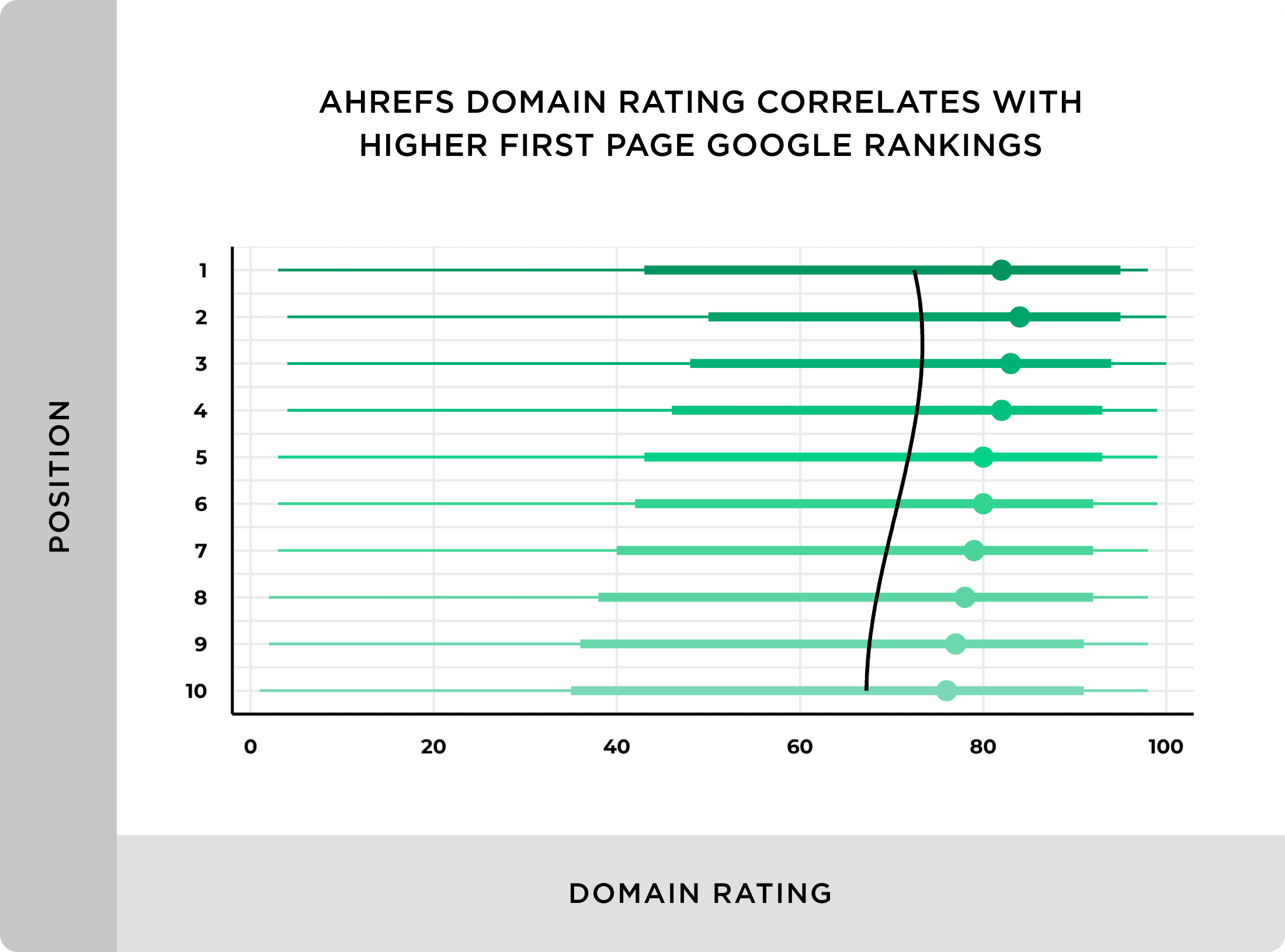
50. Page’s PageRank: Not perfectly correlated. But pages with lots of authority tend to outrank pages without much link authority.
51. URL Length: Excessively long URLs may hurt a page’s search engine visibility. In fact, several industry studies have found that short URLs tend to have a slight edge in Google’s search results.
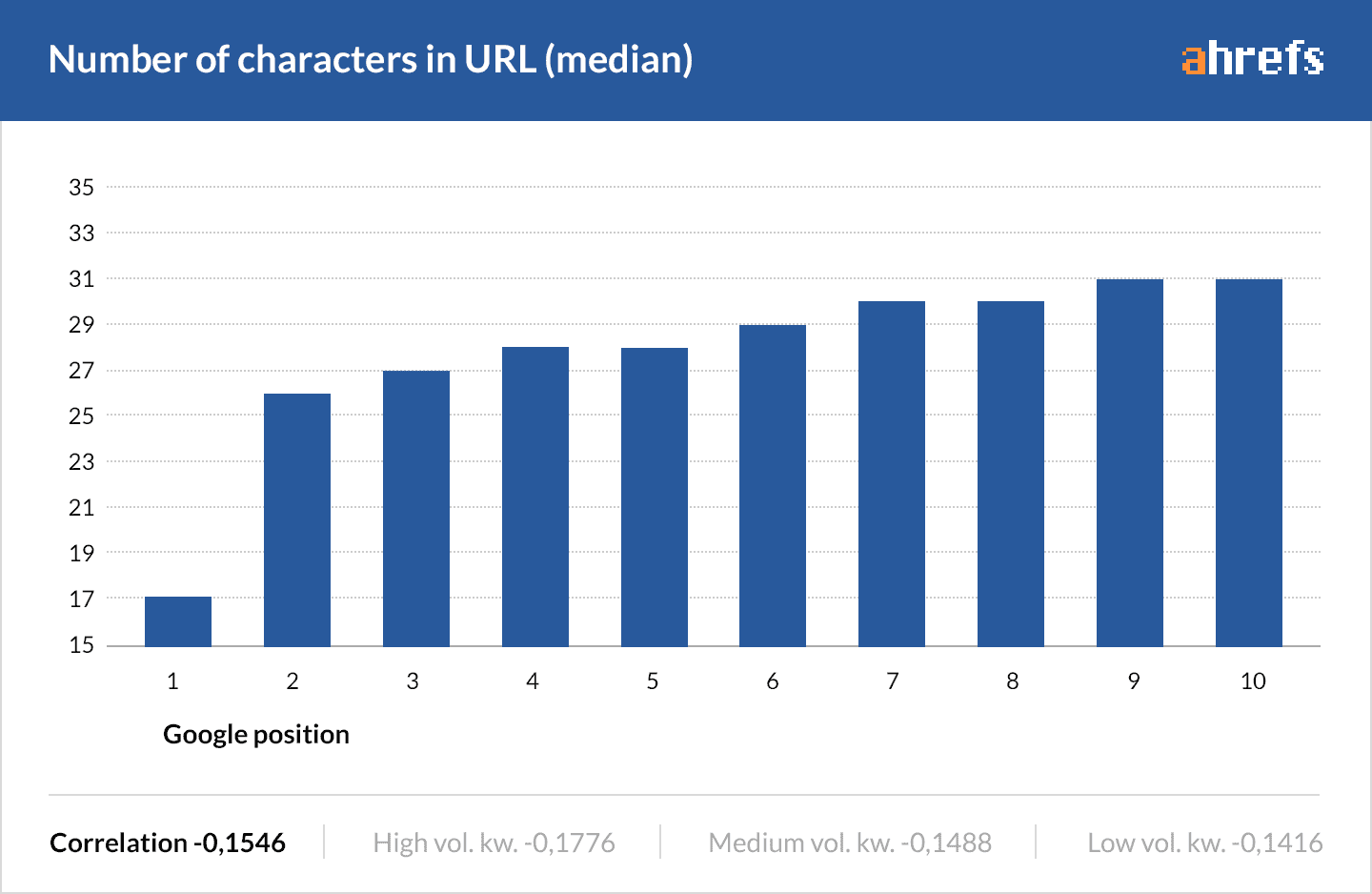
52. URL Path: A page closer to the homepage may get a slight authority boost vs. pages buried deep down in a site’s architecture.
53. Human Editors: Although never confirmed, Google has filed a patent for a system that allows human editors to influence the SERPs.
54. Page Category: The category the page appears on is a relevancy signal. A page that’s part of a closely related category may get a relevancy boost compared to a page that’s filed under an unrelated category.
55. Keyword in URL: Another relevancy signal. A Google rep recently called this a “a very small ranking factor“. But a ranking factor nontheless.
56. URL String: The categories in the URL string are read by Google and may provide a thematic signal to what a page is about:

57. References and Sources: Citing references and sources, like research papers do, may be a sign of quality. The Google Quality Guidelines states that reviewers should keep an eye out for sources when looking at certain pages: “This is a topic where expertise and/or authoritative sources are important…”. However, Google has denied that they use external links as a ranking signal.
58. Bullets and Numbered Lists: Bullets and numbered lists help break up your content for readers, making them more user friendly. Google likely agrees and may prefer content with bullets and numbers.
59. Priority of Page in Sitemap: The priority a page is given via the sitemap.xml file may influence ranking.
60. Too Many Outbound Links: Straight from the aforementioned Quality rater document:
“Some pages have way, way too many links, obscuring the page and distracting from the Main Content.”
61. UX Signals From Other Keywords Page Ranks For: If the page ranks for several other keywords, it may give Google an internal sign of quality. In fact, Google’s recent “How Search Works” report states:
“We look for sites that many users seem to value for similar queries.”
62. Page Age: Although Google prefers fresh content, an older page that’s regularly updated may outperform a newer page.
63. User Friendly Layout: Citing the Google Quality Guidelines Document yet again:
“The page layout on highest quality pages makes the Main Content immediately visible.”
64. Parked Domains: A Google update in December of 2011 decreased search visibility of parked domains.
65. Useful Content: As pointed out by Backlinko reader Jared Carrizales, Google may distinguish between “quality” and “useful” content.
Site-Level Factors
66. Content Provides Value and Unique Insights: Google has stated that they’re happy to penalize sites that don’t bring anything new or useful to the table, especially thin affiliate sites.
67. Contact Us Page: The aforementioned Google Quality Document states that they prefer sites with an “appropriate amount of contact information”. Make sure that your contact information matches your whois info.
68. Domain Trust/TrustRank: Many SEOs believe that “TrustRank” is a massively important ranking factor. And a Google Patent titled “Search result ranking based on trust”, seems to back this up.
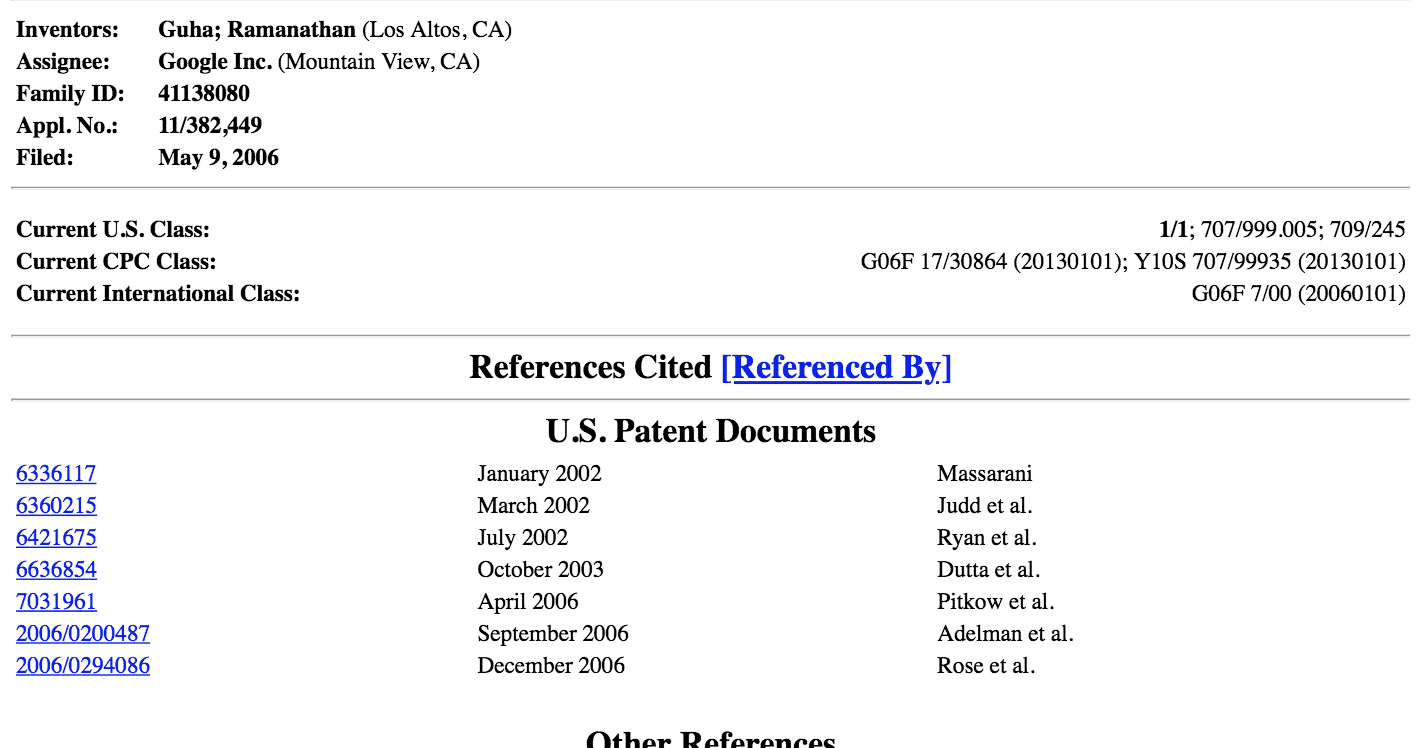
69. Site Architecture: A well put-together site architecture (for example, a silo structure) helps Google thematically organize your content. It can also helps Googlebot access and index all of your site’s pages.
70. Site Updates: Many SEOs believe that website updates — and especially when new content is added to the site — works a site-wide freshness factor. Although Google has recently denied that they use “publishing frequency” in their algorithm.
71. Presence of Sitemap: A sitemap helps search engines index your pages easier and more thoroughly, improving visibility. However, Google recently stated that HTML sitemaps aren’t “useful” for SEO.
72. Site Uptime: Lots of downtime from site maintenance or server issues may hurt your rankings (and can even result in deindexing if not corrected).
73. Server Location: Server location influences where your site ranks in different geographical regions (source). Especially important for geo-specific searches.
74. SSL Certificate: Google has confirmed that use HTTPS as a ranking signal.
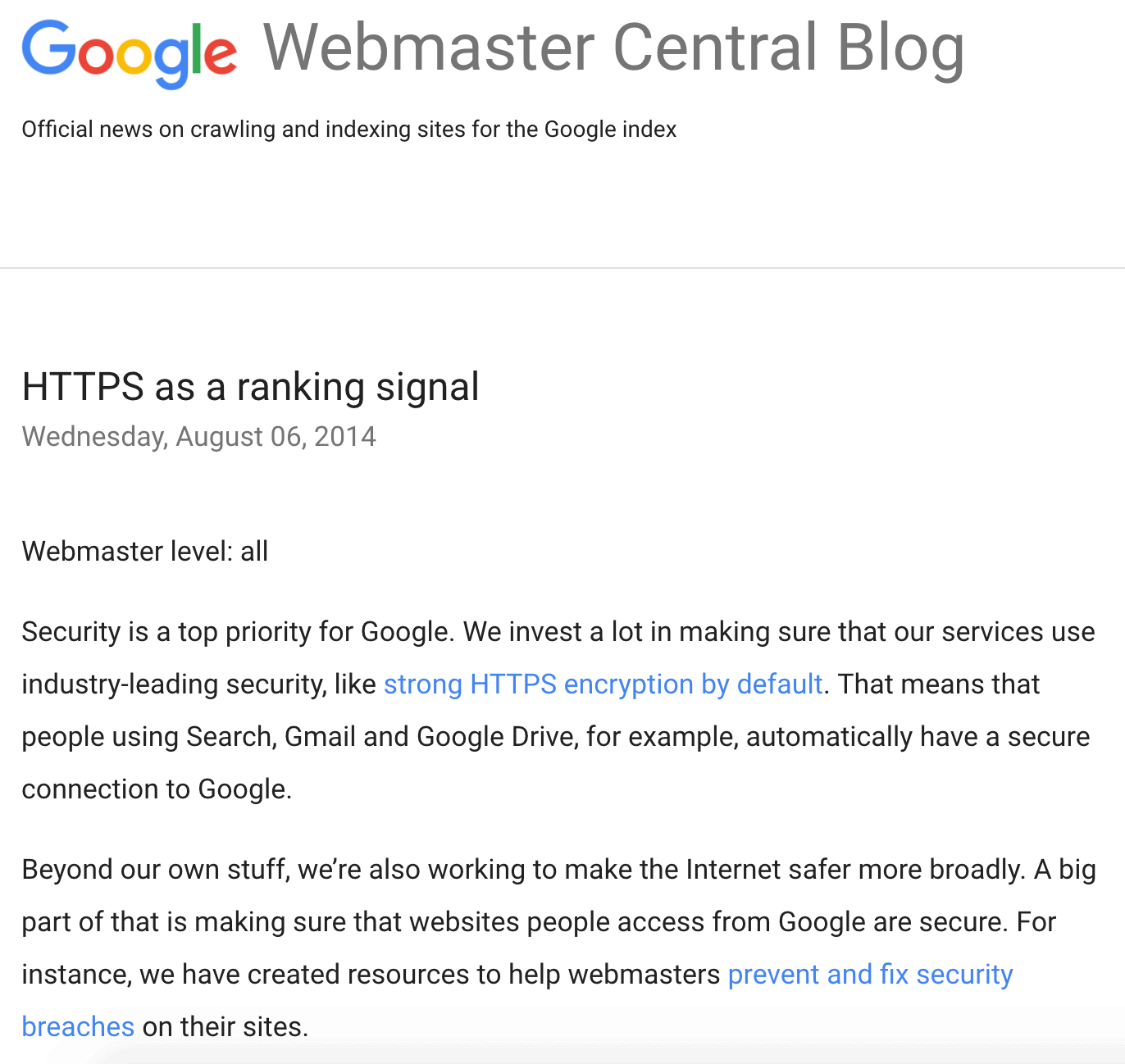
According to Google, however, HTTPS only acts as a “tiebreaker“.
75. E-A-T: Short for “Expertise, Authoritativeness, Trustworthiness”. Google may give an edge to sites with high levels of E-A-T (especially sites that publish health-related content).
76. Duplicate Meta Information On-Site: Duplicate meta information across your site may bring down all of your page’s visibility.
77. Breadcrumb Navigation: This is a style of user-friendly site-architecture that helps users (and search engines) know where they are on a site:

Google states that: “Google Search uses breadcrumb markup in the body of a web page to categorize the information from the page in search results.”
78. Mobile Optimized: With more than half of all searches done from mobile devices, Google wants to see that your site is optimized for mobile users. In fact, Google now penalizes websites that aren’t mobile friendly
79. YouTube: There’s no doubt that YouTube videos are given preferential treatment in the SERPs (probably because Google owns it ):

In fact, Search Engine Land found that YouTube.com traffic increased significantly after Google Panda.
80. Site Usability: A site that’s difficult to use or to navigate can hurt rankings indirectly by reducing time on site, pages viewed and bounce rate (in other words, RankBrain ranking factors).
81. Use of Google Analytics and Google Search Console: Some think that having these two programs installed on your site can improve your page’s indexing. They may also directly influence rankings by giving Google more data to work with (ie. more accurate bounce rate, whether or not you get referral traffic from your backlinks etc.). That said, Google has denied this as a myth.
82. User reviews/Site reputation: A site’s reputation on sites like Yelp.com likely play an important role in Google’s algorithm. Google even posted a rarely candid outline of how they use online reviews after one site was caught ripping off customers in an effort to get press and links.
83. Core Web Vitals: Core Web Vitals are “more than a tiebreaker” in terms of their impact on rankings.
Backlink Factors
84. Linking Domain Age: Backlinks from aged domains may be more powerful than from new domains.
85. # of Linking Root Domains: The number of referring domains is one of the most important ranking factors in Google’s algorithm, as you can see from our industry study of 11.8 million Google Search results.
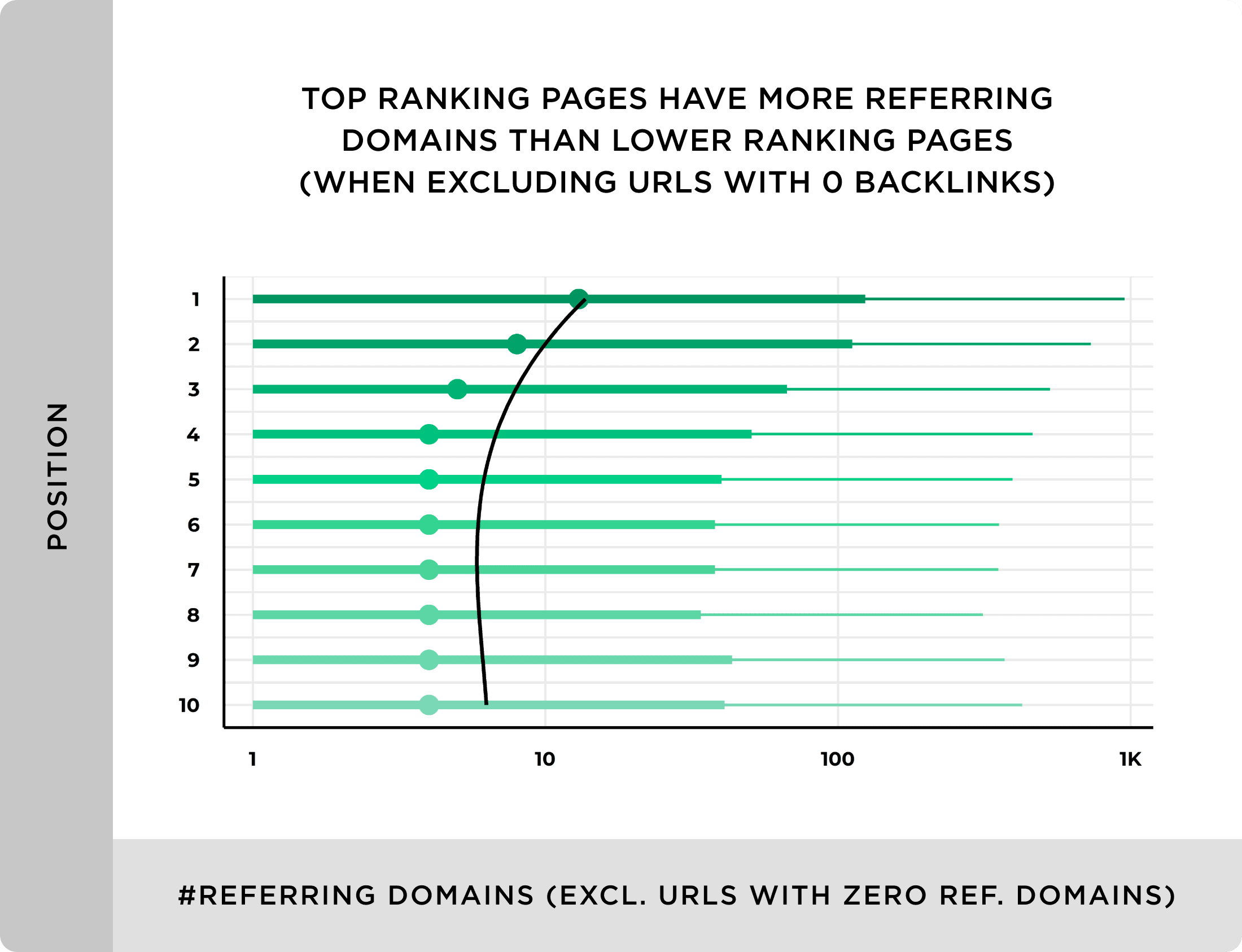
86. # of Links from Separate C-Class IPs: Links from separateIP addresses suggest a wider breadth of sites linking to you, which can help with rankings.
87. # of Linking Pages: The total number of linking pages (even from the same domain) may impact rankings.
88. Backlink Anchor Text: As noted in this description of Google’s original algorithm:
“First, anchors often provide more accurate descriptions of web pages than the pages themselves.”
Obviously, anchor text is less important than before (and, when over-optimized, work as a webspam signal). But keyword-rich anchor text still sends a strong relevancy signal in small doses.
89. Alt Tag (for Image Links): Alt text acts as anchor text for images.
90. Links from .edu or .gov Domains: Matt Cutts has stated that TLD doesn’t factor into a site’s importance. And Google has said they “ignore” lots of Edu links. However, that doesn’t stop SEOs from thinking that there’s a special place in the algorithm for .gov and .edu TLDs.
91. Authority of Linking Page: The authority (PageRank) of the referring page has been an extremely important ranking factor since Google’s early days and still is.

92. Authority of Linking Domain: The referring domain’s authority may play an independent role in a link’s value.
93. Links From Competitors: Links from other pages ranking in the same SERP may be more valuable to a page’s ranking for that particular keyword (due to the fact that they’re highly relevant pages).
94. Links from “Expected” Websites: Although speculative, some SEOs believe that Google won’t fully trust your website until you get linked to from a set of “expected” authority sites in your industry.
95. Links from Bad Neighborhoods: Links from so-called “bad neighborhoods” may hurt your site.
96. Guest Posts: Although links from guest posts still pass value, they likely aren’t as powerful as true editorial links (plus, “large-scale” guest posting can get your site into trouble).
97. Links From Ads: According to Google, links from ads should be nofollowed or use the rel=sponsored attribute. However, it’s likely that Google is able to identify and filter out followed links from ads.
98. Homepage Authority: Links to a referring page’s homepage may play special importance in evaluating a site’s — and therefore a link’s — weight.
99. Nofollow Links: This is one of the most controversial topics in SEO. Google’s official word on the matter is:
“In general, we don’t follow them.”
Which suggests that they do… at least in certain cases. Having a certain % of nofollow links may also indicate a natural vs. unnatural link profile.
100. Diversity of Link Types: Having an unnaturally large percentage of your links coming from a single source (ie. forum profiles, blog comments) may be a sign of webspam. On the other hand, links from diverse sources is a sign of a natural link profile.
101. “Sponsored” or “UGC” Tags: Links tagged as “rel=sponsored” or “rel=UGC” are treated differently than normal “followed” or rel=nofollow links.
102. Contextual Links: Links embedded inside a page’s content are considered more powerful than links on an empty page or found elsewhere on the page.

103. Excessive 301 Redirects to Page: Backlinks coming from 301 redirects dilute some PageRank, according to a Webmaster Help Video.
104. Internal Link Anchor Text: Internal link anchor text is another relevancy signal. That said, internal links likely have much less weight than anchor text coming from external sites.
105. Link Title Attribution: The link title (the text that appears when you hover over a link) may also be used as a weak relevancy signal.
106. Country TLD of Referring Domain: Getting links from country-specific top level domain extensions (.de, .cn, .co.uk) may help you rank better in that country.
107. Link Location In Content: Links in the beginning of a piece of content may carry slightly more weight than links placed at the end of the content.
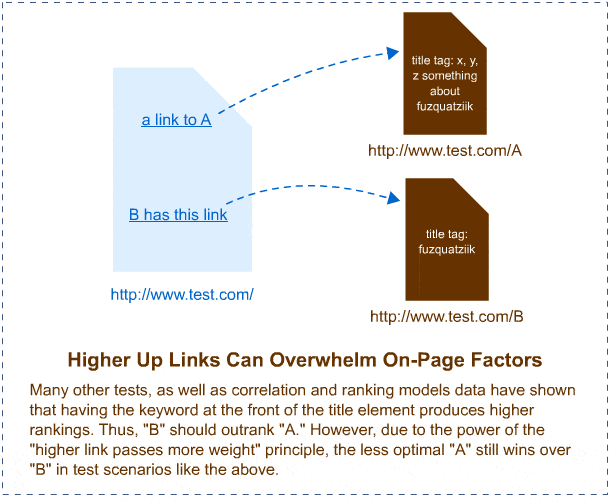
108. Link Location on Page: Where a link appears on a page is important. Generally, a link embedded in a page’s content is more powerful than a link in the footer or sidebar area.
109. Linking Domain Relevancy: A link from a site in a similar niche is significantly more powerful than a link from a completely unrelated site.
110. Page-Level Relevancy: A link from a relevant page also passes more value.
111. Keyword in Title: Google gives extra love to links from pages that contain your page’s keyword in the title (“Experts linking to experts”.)
112. Positive Link Velocity: A site with positive link velocity usually gets a SERP boost as it shows your site is increasing in popularity.

113. Negative Link Velocity: On the flip side, a negative link velocity can significantly reduce rankings as it’s a signal of decreasing popularity.
114. Links from “Hub” Pages: The Hilltop Algorithm suggests that getting links from pages that are considered top resources (or hubs) on a certain topic are given special treatment.
115. Link from Authority Sites: A link from a site considered an “authority site” likely pass more juice than a link from a small, relatively unknown site.
116. Linked to as Wikipedia Source: Although the links are nofollow, many think that getting a link from Wikipedia gives you a little added trust and authority in the eyes of search engines. Google has denied this.
117. Co-Occurrences: The words that tend to appear around your backlinks helps tell Google what that page is about.

118. Backlink Age: According to a Google patent, older links have more ranking power than newly minted backlinks.
119. Links from Real Sites vs. “Splogs”: Due to the proliferation of blog networks, Google probably gives more weight to links coming from “real sites” than from fake blogs. They likely use brand and user-interaction signals to distinguish between the two.
120. Natural Link Profile: A site with a “natural” link profile is going to rank highly and be more durable to updates than one that has clearly used black hat strategies to build links.
121. Reciprocal Links: Google’s Link Schemes page lists “Excessive link exchanging” as a link scheme to avoid.
122. User Generated Content Links: Google can identify UGC vs. content published by the actual site owner. For example, they know that a link from the official WordPress.com blog is very different than a link from besttoasterreviews.wordpress.com.
123. Links from 301: Links from 301 redirects may lose a little bit of juice compared to a direct link. However, Matt Cutts says that a 301s are similar to direct links
124. Schema.org Usage: Pages that support microformats may rank above pages without it. This may be a direct boost or the fact that pages with microformatting have a higher SERP CTR:

125. TrustRank of Linking Site: The trustworthiness of the site linking to you determines how much “TrustRank” gets passed on to you.
126. Number of Outbound Links on Page: PageRank is finite. A link on a page with hundreds of external links passes less PageRank than a page with a handful of outbound links.
127. Forum Links: Because of industrial-level spamming, Google may significantly devalue links from forums.
128. Word Count of Linking Content: A link from a 1000-word post is usually more valuable than a link inside of a 25-word snippet.
129. Quality of Linking Content: Links from poorly written or spun content don’t pass as much value as links from well-written, content.
130. Sitewide Links: Matt Cutts has confirmed that sitewide links are “compressed” to count as a single link.
User Interaction
131. RankBrain: RankBrain is Google’s AI algorithm. Many believe that its main purpose is to measure how users interact with the search results (and rank the results accordingly).
132. Organic Click Through Rate for a Keyword: According to Google, pages that get clicked more in CTR may get a SERP boost for that particular keyword.

133. Organic CTR for All Keywords: A site’s organic CTR for all keywords it ranks for may be a human-based, user interaction signal (in other words, a “Quality Score” for the organic results).
134. Bounce Rate: Not everyone in SEO agrees bounce rate matters, but it may be a way of Google to use their users as quality testers (after all, pages with a high bounce rate probably aren’t a great result for that keyword). Also, a large study by SEMRush found a correlation between bounce rate and Google rankings.
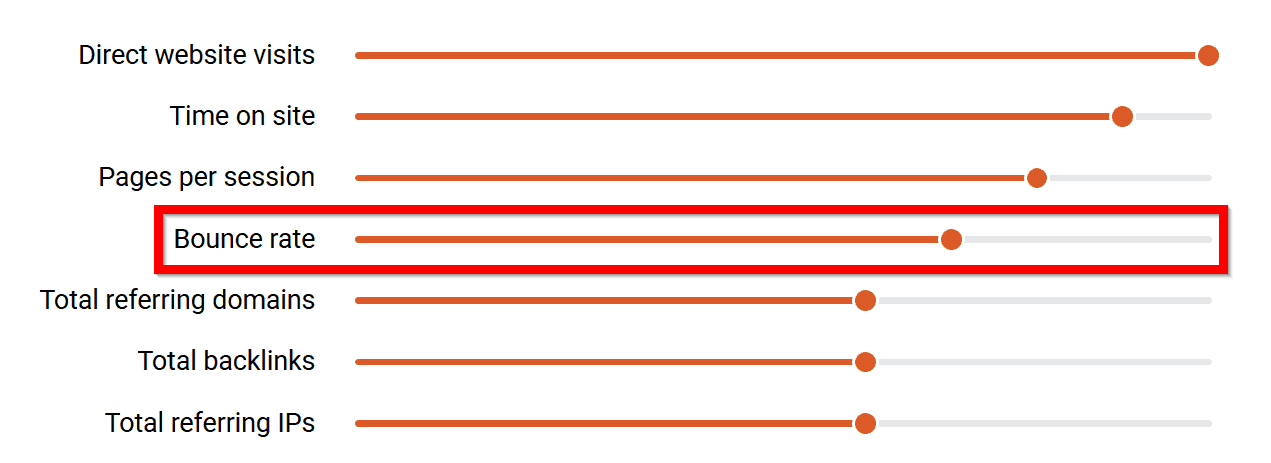
135. Direct Traffic: It’s confirmed that Google uses data from Google Chrome to determine how many people visit site (and how often). Sites with lots of direct traffic are likely higher quality sites vs. sites that get very little direct traffic. In fact, the SEMRush study I just cited found a significant correlation between direct traffic and Google rankings.
136. Repeat Traffic: Sites with repeat visitors may get a Google ranking boost.
137. Pogosticking: “Pogosticking” is a special type of bounce. In this case, the user clicks on other search results in an attempt to find the answer to their query.
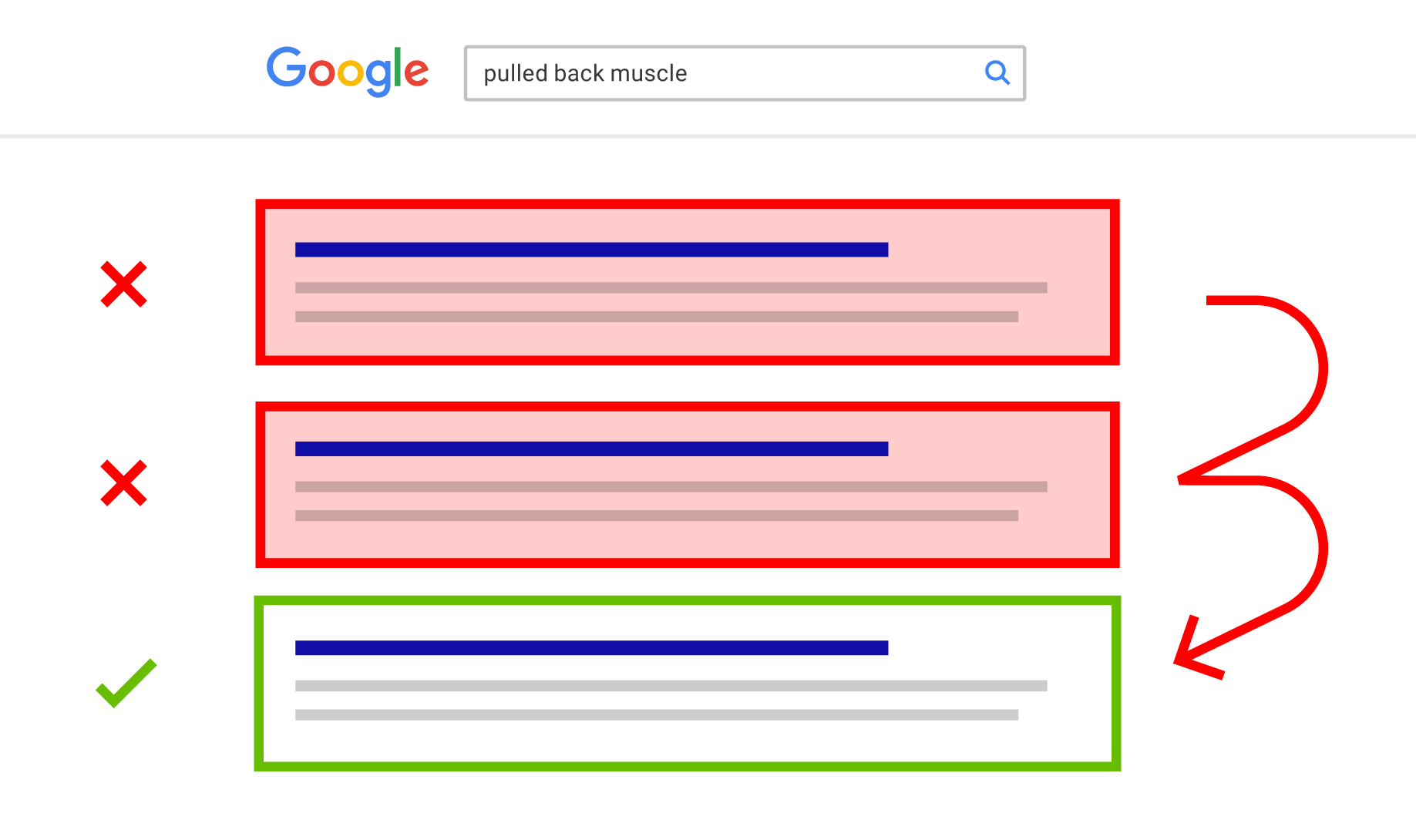
Results that people Pogostick from may get a significantly rankings drop.
138. Blocked Sites: Google has discontinued this feature in Chrome. However, Panda used this feature as a quality signal. So Google may still use a variation of it.
139. Chrome Bookmarks: We know that Google collects Chrome browser usage data. Pages that get bookmarked in Chrome might get a boost.
140. Number of Comments: Pages with lots of comments may be a signal of user-interaction and quality. In fact, one Googler said comments can help “a lot” with rankings.
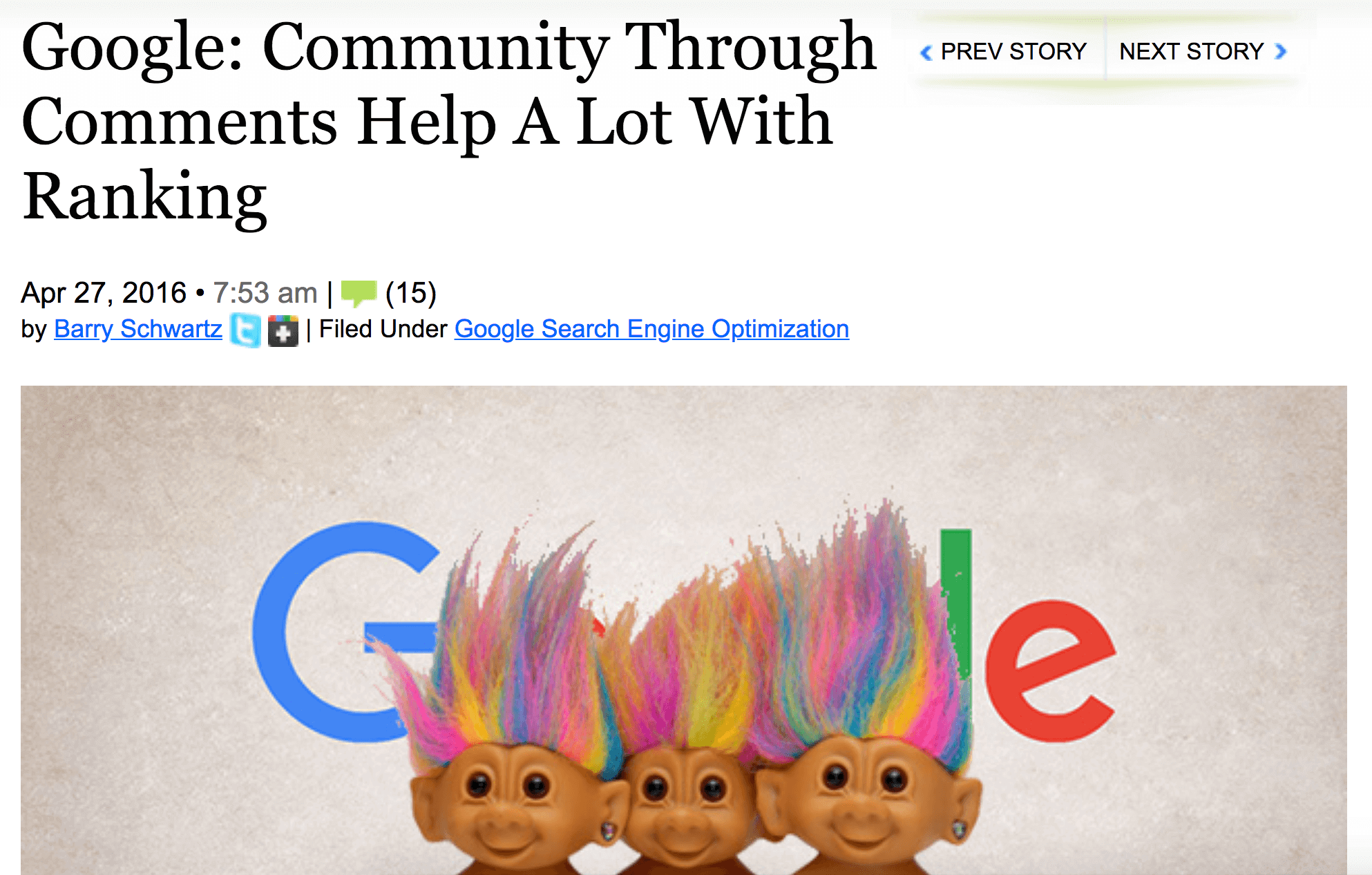
141. Dwell Time: Google pays very close attention to “dwell time“: how long people spend on your page when coming from a Google search. This is also sometimes referred to as “long clicks vs short clicks”. In short: Google measures how long Google searchers spend on your page. The longer time spent, the better.
Special Google Algorithm Rules
142. Query Deserves Freshness: Google gives newer pages a boost for certain searches.
143. Query Deserves Diversity: Google may add diversity to a SERP for ambiguous keywords, such as “Ted”, “WWF” or “ruby”.
144. User Browsing History: You’ve probably noticed this yourself: websites that you visit frequently get a SERP boost for your searches.
145. User Search History: Search chain influence search results for later searches. For example, if you search for “reviews” then search for “toasters”, Google is more likely to rank toaster review sites higher in the SERPs.
146. Featured Snippets: According to an SEMRush study, Google chooses Featured Snippets content based on a combination of content length, formatting, page authority and HTTPs usage.
147. Geo Targeting: Google gives preference to sites with a local server IP and country-specific domain name extension.
148. Safe Search: Search results with curse words or adult content won’t appear for people with Safe Search turned on.
149. “YMYL” Keywords: Google has higher content quality standards for “Your Money or Your Life” keywords.
150. DMCA Complaints: Google “downranks” pages with legitimate DMCA complaints.
151. Domain Diversity: The so-called “Bigfoot Update” supposedly added more domains to each SERP page.
152. Transactional Searches: Google sometimes displays different results for shopping-related keywords, like flight searches.

153. Local Searches: For local searches, Google often places local results above the “normal” organic SERPs.

154. Top Stories box: Certain keywords trigger a Top Stories box:
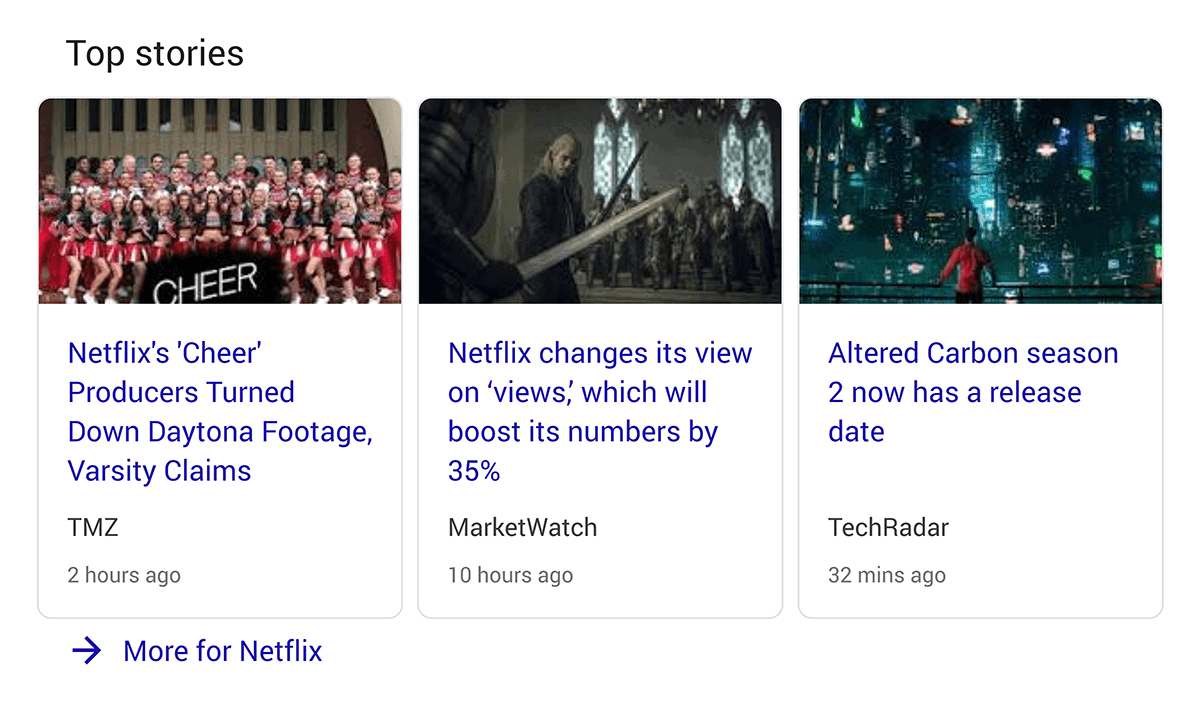
155. Big Brand Preference: After the Vince Update, Google began giving big brands a boost for certain keywords.
156. Shopping Results: Google sometimes displays Google Shopping results in organic SERPs:

157. Image Results: Google images sometimes appear in the normal, organic search results.
158. Easter Egg Results: Google has a dozen or so Easter Egg results. For example, when you search for “Atari Breakout” in Google image search, the search results turn into a playable game (!). Shout out to Victor Pan for this one.
159. Single Site Results for Brands: Domain or brand-oriented keywords bring up several results from the same site.
160. Payday Loans Update: This is a special algorithm designed to clean up “very spammy queries“.
Brand Signals
161. Brand Name Anchor Text: Branded anchor text is a simple — but strong — brand signal.

162. Branded Searches: People search for brands. If people search for your brand in Google, this shows Google that your site is a real brand.
163. Brand + Keyword Searches: Do people search for a specific keyword along with your brand (for example: “Backlinko Google ranking factors” or “Backlinko SEO”)? If so, Google may give you a rankings boost when people search for the non-branded version of that keyword in Google.
164. Site Has Facebook Page and Likes: Brands tend to have Facebook pages with lots of likes.
165. Site has Twitter Profile with Followers: Twitter profiles with a lot of followers signals a popular brand.
166. Official Linkedin Company Page: Most real businesses have company Linkedin pages.
167. Known Authorship: In February 2013, Google CEO Eric Schmidt famously claimed:
“Within search results, information tied to verified online profiles will be ranked higher than content without such verification, which will result in most users naturally clicking on the top (verified) results.”
168. Legitimacy of Social Media Accounts: A social media account with 10,000 followers and 2 posts is probably interpreted a lot differently than another 10,000-follower strong account with lots of interaction. In fact, Google filed a patent for determining whether or not social media accounts were real or fake.
169. Brand Mentions on Top Stories: Really big brands get mentioned on Top Stories sites all the time. In fact, some brands even have a feed of news from their own website, on the first page:
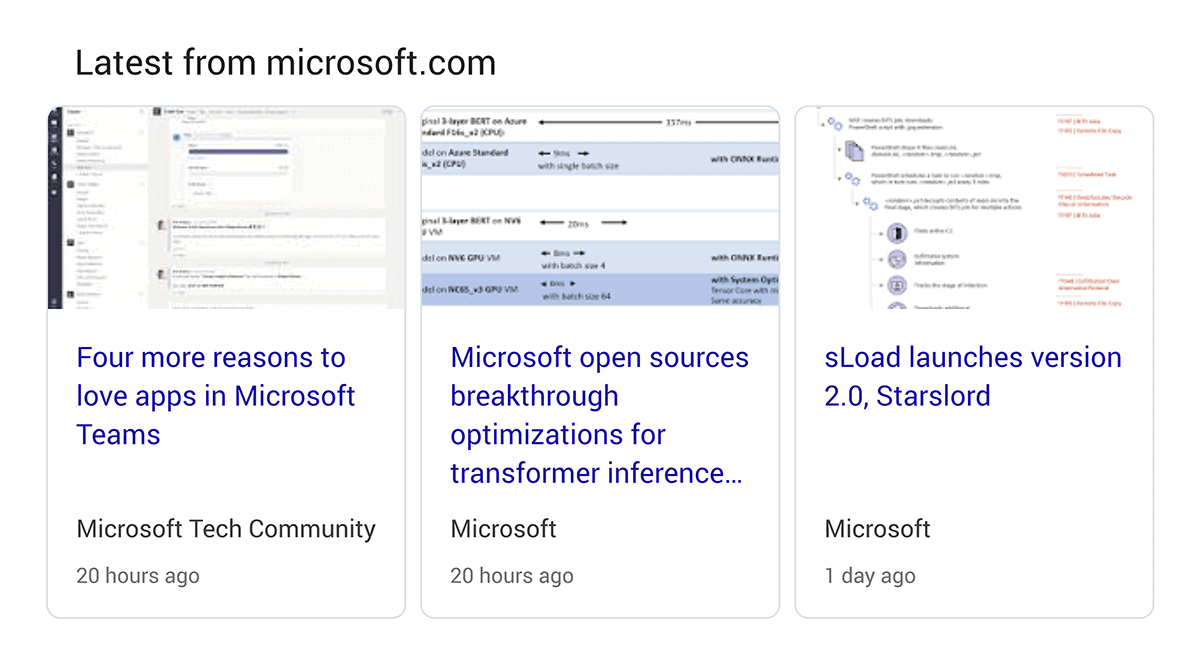
170. Unlinked Brand Mentions: Brands get mentioned without getting linked to. Google likely looks at non-hyperlinked brand mentions as a brand signal.
171. Brick and Mortar Location: Real businesses have offices. It’s possible that Google fishes for location-data to determine whether or not a site is a big brand.
On-Site Webspam Factors
172. Panda Penalty: Sites with low-quality content (particularly content farms) are less visible in search after getting hit by a Panda penalty.
173. Links to Bad Neighborhoods: Linking out to “bad neighborhoods” — like spammy pharmacy or payday loan sites — may hurt your search visibility.
174. Redirects: Sneaky redirects is a big no-no. If caught, it can get a site not just penalized, but de-indexed.
175. Popups or “Distracting Ads”: The official Google Rater Guidelines Document says that popups and distracting ads is a sign of a low-quality site.
176. Interstitial Popups: Google may penalize sites that display full page “interstitial” popups to mobile users.

177. Site Over-Optimization: Yes, Google does penalize people for over-optimizing their site. This includes: keyword stuffing, header tag stuffing, excessive keyword decoration.
178. Gibberish Content: A Google Patent outlines how Google can identify “gibberish” content, which is helpful for filtering out spun or auto-generated content from their index.
179. Doorway Pages: Google wants the page you show to Google to be the page that user ultimately see. If your page redirects people to another page, that’s a “Doorway Page”. Needless to say, Google doesn’t like sites that use Doorway Pages.
180. Ads Above the Fold: The “Page Layout Algorithm” penalizes sites with lots of ads (and not much content) above the fold.
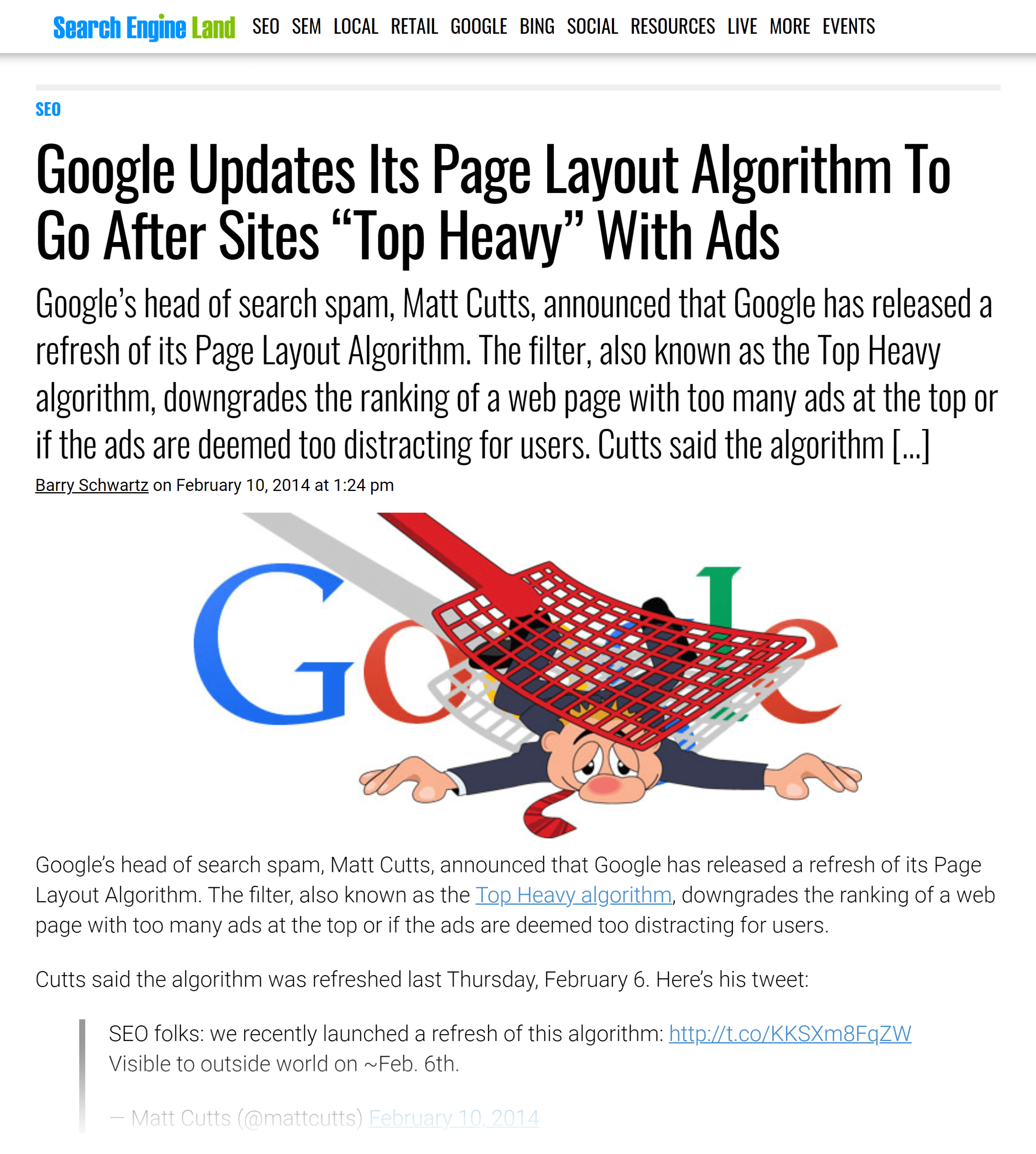
181. Hiding Affiliate Links: Going too far when trying to hide affiliate links (especially with cloaking) can bring on a penalty.
182. Fred: A nickname given to a series of Google updates starting in 2017. According to Search Engine Land, Fred “targets low-value content sites that put revenue above helping their users.”
183. Affiliate Sites: It’s no secret that Google isn’t the biggest fan of affiliates. And many think that sites that monetize with affiliate programs are put under extra scrutiny.
184. Autogenerated Content: Google understandably hates autogenerated content. If they suspect that your site’s pumping out computer-generated content, it could result in a penalty or de-indexing.
185. Excess PageRank Sculpting: Going too far with PageRank sculpting — by nofollowing all outbound links — may be a sign of gaming the system.
186. IP Address Flagged as Spam: If your server’s IP address is flagged for spam, it may affect all sites on that server.
187. Meta Tag Spamming: Keyword stuffing can also happen in meta tags. If Google thinks you’re adding keywords to your title and description tags in an effort to game the algo, they may hit your site with a penalty.
Off-Site Webspam Factors
188. Hacked Site: If your site gets hacked it can get dropped from the search results. In fact, Search Engine Land was completed deindexed after Google thought it had been hacked.
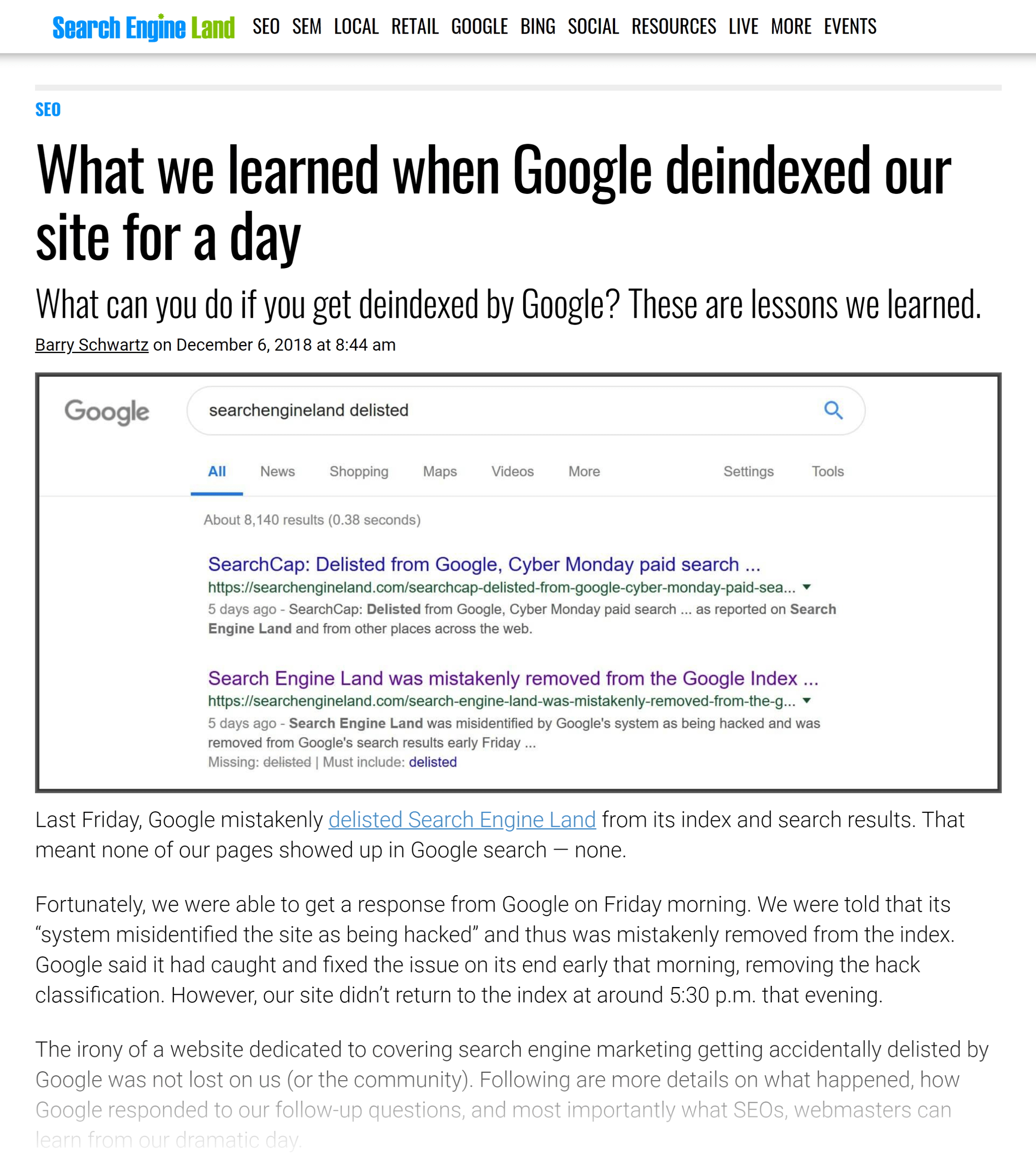
189. Unnatural Influx of Links: A sudden (and unnatural) influx of links is a sure-fire sign of phony links.
190. Penguin Penalty: Sites that were hit by Google Penguin are significantly less visible in search. Although, apparently, Penguin now focuses more on filtering out bad links vs. penalizing entire websites.
191. Link Profile with High % of Low Quality Links: Lots of links from sources commonly used by black hat SEOs (like blog comments and forum profiles) may be a sign of gaming the system.
192. Links From Unrelated Websites: A high-percentage of backlinks from topically-unrelated sites can increase the odds of a manual penalty.
193. Unnatural Links Warning: Google has sent out thousands of “Google Search Console notice of detected unnatural links” messages. This usually precedes a ranking drop, although not 100% of the time.
194. Low-Quality Directory Links: According to Google, backlinks from low-quality directories can lead to a penalty.
195. Widget Links: Google frowns on links that are automatically generated when user embeds a “widget” on their site.
196. Links from the Same Class C IP: Getting an unnatural amount of links from sites on the same server IP may help Google determine that your links are coming from a blog network.
197. “Poison” Anchor Text: Having “poison” anchor text (especially pharmacy keywords) pointed to your site may be a sign of spam or a hacked site. Either way, it can hurt your site’s ranking.
198. Unnatural Link Spike: A 2013 Google Patent describes how Google can identify whether or not an influx of links to a page is legitimate. Those unnatural links may become devalued.
199. Links From Article Directories and Press Releases: Articles directories and press releases has been abused to the point that Google now considers these two link building strategies a “link scheme” in many cases.
200. Manual Actions: There are several types of these, but most are related to black hat link building.
201. Selling Links: Getting caught selling links can hurt your search visibility.
202. Google Sandbox: New sites that get a sudden influx of links are sometimes put in the Google Sandbox, which temporarily limits search visibility.
203. Google Dance: The Google Dance can temporarily shake up rankings. According to a Google Patent, this may be a way for them to determine whether or not a site is trying to game the algorithm.
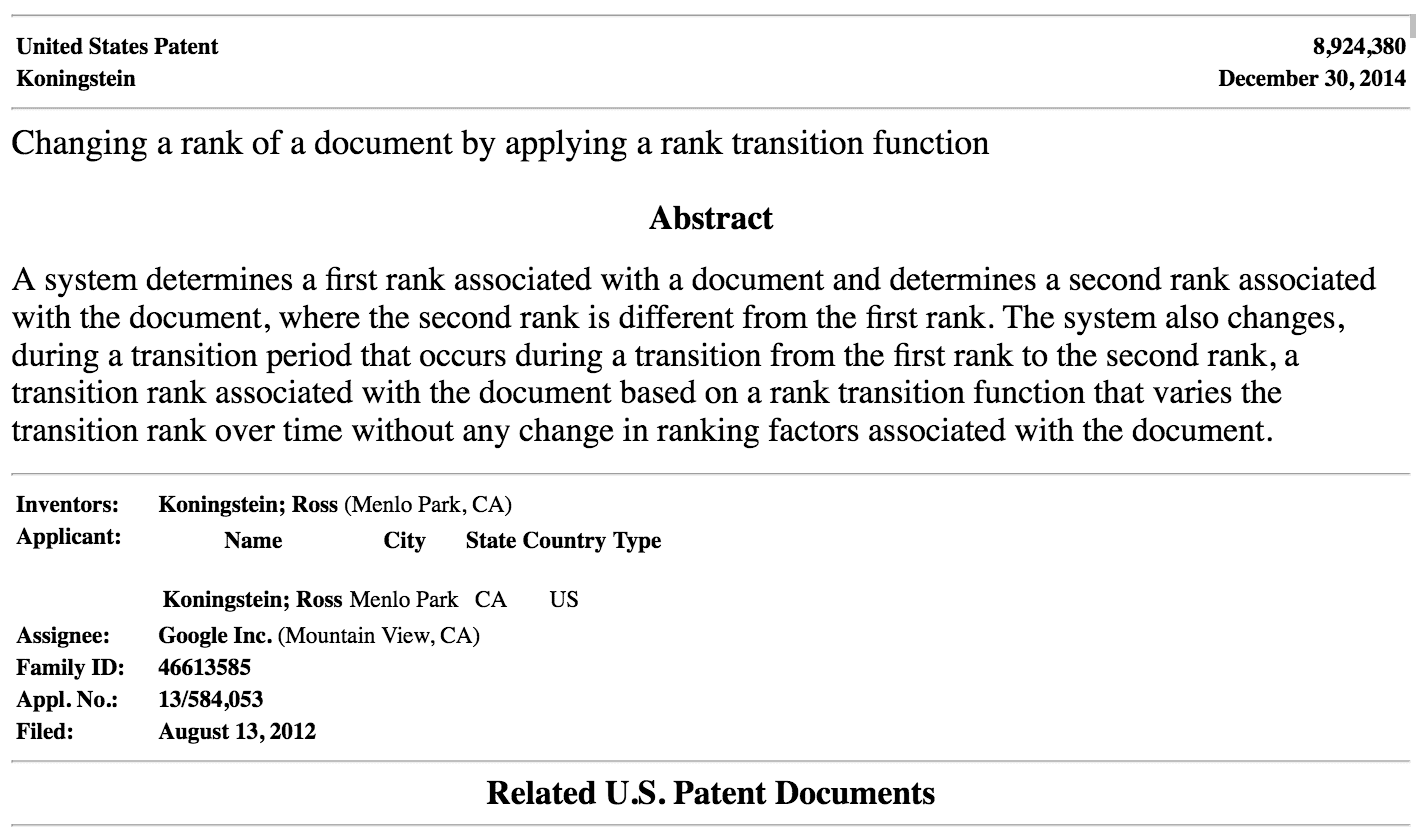
204. Disavow Tool: Use of the Disavow Tool may remove a manual or algorithmic penalty for sites that were the victims of negative SEO.
205. Reconsideration Request: A successful reconsideration request can lift a penalty.
206. Temporary Link Schemes: Google has caught onto people that create — and quickly remove — spammy links. Also know as a temporary link scheme.
Conclusion
That’s quite a list.
To summarize, here are the 8 most important Google ranking factors in 2024:
- Quality Content: Content is king! Create informative, engaging, and valuable content that users seek.
- Backlinks: Earn high-quality backlinks from reputable websites to boost your credibility.
- Technical SEO: Ensure your website is technically sound, fast, mobile-friendly, and easy to crawl.
- Keyword Optimization: Use relevant keywords strategically throughout your content.
- User Experience (UX): Prioritize user experience by making your website easy to navigate, clean, and mobile-friendly.
- Schema Markup: Implement schema markup to help search engines better understand your content.
- Social Signals: Encourage social interaction and engagement with your website’s content.
- Brand Signals: Build a strong brand reputation and online presence to improve search rankings.
Now I’d like to hear from you:
Which SEO ranking factor from this list was new to you?
Or maybe I missed something.
Either way, let me know by leaving a comment below.




